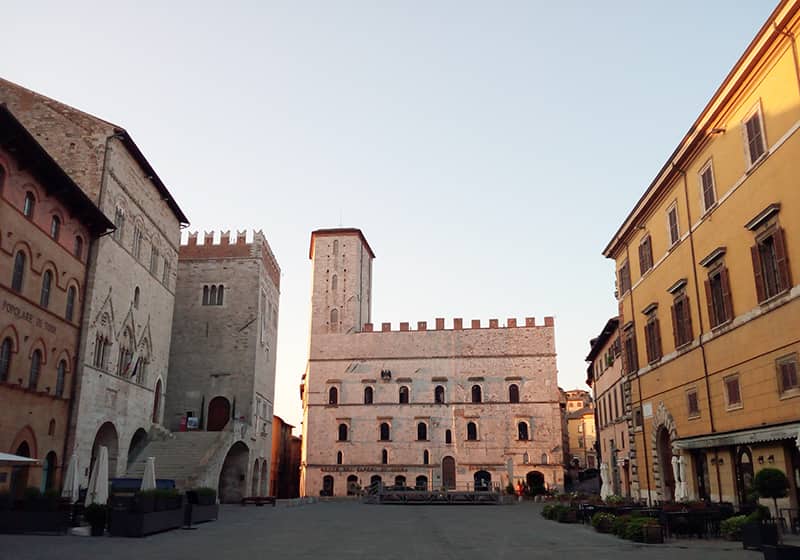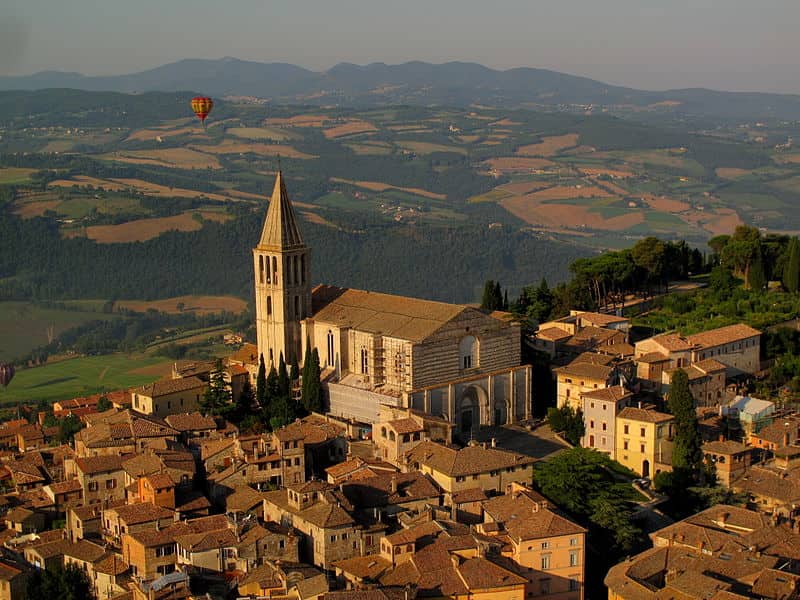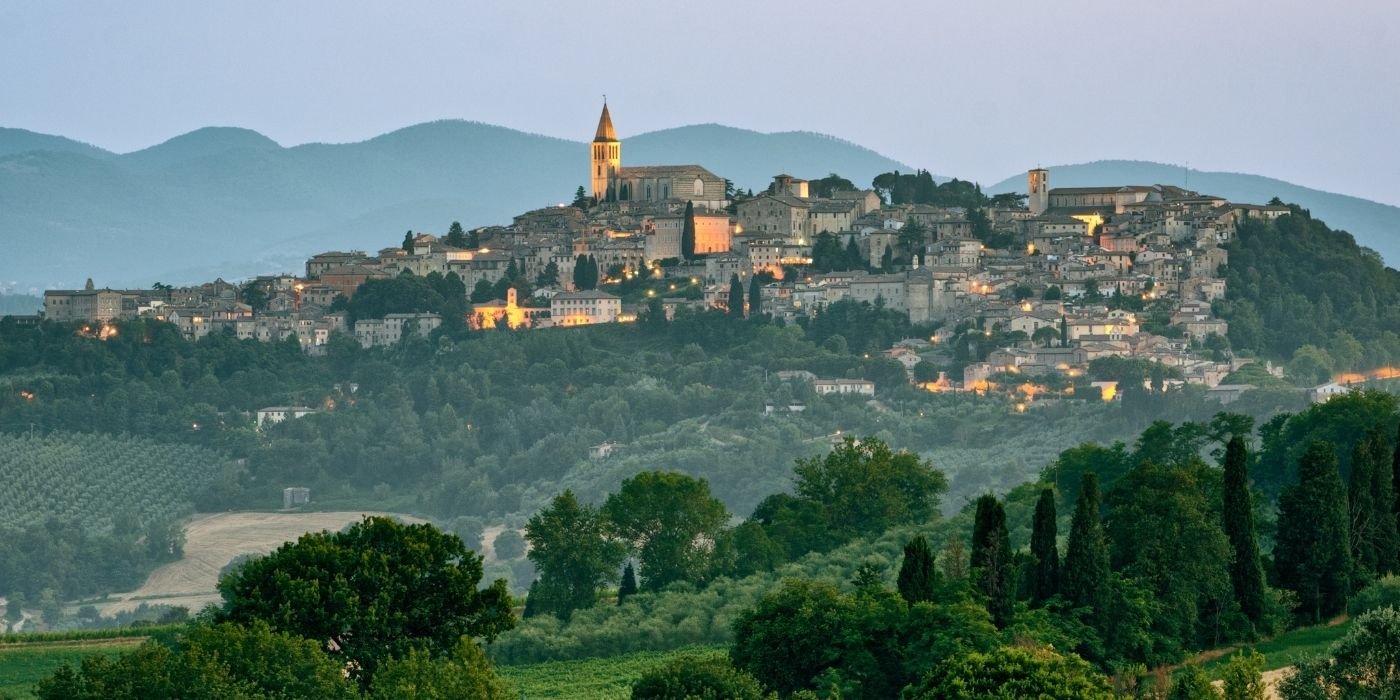Despite this, this tiny town has yet to be discovered by real mass tourism and perhaps this is why it has preserved the charm of a timeless place.

The city center: Piazza del Popolo

A short break in Todi will probably begin from its large rectangular main square, the heart of the city, now as back in the days. Basically Piazza del Popolo has preserved the typical layout of medieval Italian squares, where secular and religious power faced each other.
The Church of the Santissima Annunziata, the cathedral of Todi, dominates the whole square; it's an imposing and sober building located in a privileged position, at the top of a long staircase. Inside you can admire the wooden crucifix on the altar, the fresco that decorates the counter-façade and that quotes Michelangelo's Last Judgment and the suggestive underground crypt.
Right in front of the Cathedral is Palazzo dei Priori a building with a massive tower and a bronze eagle, the symbol of the city, to decorate the facade.
On one of the long sides of the square there are two other awesome thirteenth-century buildings, Palazzo del Popolo and Palazzo del Capitano, which share an impressive access staircase. Inside are the Civic Museum, the Lapidary Museum and some rooms for cultural events or contemporary art exhibitions. The ground floor, on the other hand, consists of a large loggia that the locals call the Voltoni, where with a little luck you can find a market of typical products, including the unmissable Umbrian cheeses and meats.
The churches of Todi

Besides its beautiful cathedral Todi has a number of interesting churches to visit, three of them just can't be missed.
Outside the walls, at the foot of the hill, is the Temple of Santa Maria della Consolazione, an imposing Renaissance style church whose project is attributed to Bramante. Here the pilgrims went to pray to a sacred icon which, according to legend, had the power to heal diseases.
The lesser known church of the Santissima Nunziatina is certainly worth a visit as well. This small seventeenth-century gem has the interiors entirely frescoed in Baroque style.
Last but not least, there is the Church of San Fortunato, located at the entrance to the historic center. The facade is unfinished but in the lower register there are three beautiful gothic portals, very richly decorated. Inside rests the poet Jacopone, but there are also other important relics of saints. There is a long and wide staircase leading to the church and hidden between the stone steps is a trap door which is one of the access points to Underground Todi.
Todi Underground
Todi is truly an inexhaustible source of surprises, so much so that even its subsoil holds itineraries of great interest. The area known as Todi Underground is a route of about 3 km that includes cisterns dating back to the pre-Roman era, aqueducts and cellars.
Among the most interesting sites are the Roman cisterns below what was once the forum and has later become Piazza del Popolo. They are very large rooms that date back to the first century BC, but only one of them can be visited today, thanks to an easy staircase recently added.
The so-called “neviera” in via delle Mura Etrusche is very interesting too. It is an underground room where the snow and ice collected during the winter could be kept for many months, if not years, thanks to a double wall with a cavity that guaranteed thermal insulation.
There is also a network of about 600 meters of rather large tunnels, still accessible, known as the Gallerie della Fabbrica della Piana, dating back to the 18th century.
Among the many things to see in Todi there are also interesting testimonies of the Roman age, starting from the city walls. There are three walls surrounding the center. The more external ones, better preserved, are from the Middle Ages, but the other two, the more internal ones, which have come down to us only in fragments, date back to the Roman era. This also includes the so-called Etruscan walls which, despite the name, were in fact built after the years of the the Etruscan domination of the land, by the Romans indeed.
Along the road that leads to Piazza del Mercato Vecchio there are four huge travertine apses of the firs years of the imperial age. According to some, these are the remains of a temple dedicated to Mars, according to others they simply had a static function, what is certain is that they offer a majestic spectacle.
Todi's panoramic views

There is so much to see in Todi that you may feel the need to rush your visit so as not to miss anything, but a trip to this delightful village would not be complete if you did not take the time to admire one of its major attractions: the views on the green Umbrian hills, to be savored without haste, to rest the body and pamper the soul.
One of the most famous viewpoints is the Giardini di Oberdan, a small city park a stone's throw from the center, with benches and flower beds from which to admire both the valley below and the village's little houses. Adjacent to Piazza del Popolo is Piazza Garibaldi with its long terrace on the opposite side of the hill.
The long road that leads out of town, up to the imposing church of Santa Maria della Consolazione, offers the chance for an easy walk from which to enjoy memorable views of Todi itself. From here, early risers will be able to admire wonderful sunrises, with the rising sun painting the sky and the sleepy town pink.
No less fascinating is the belvedere located along the ancient walls, above Piazza del Montarone. Reaching this place is also the perfect opportunity to get lost in the quiet and suggestive alleys of Todi.
Finally, on the highest point of the city stands the Rocca di Todi, a beautiful green area that houses the ruins of a fourteenth-century fortress that was destroyed several times and then rebuilt by the inhabitants of the city themselves; it is the perfect place to rest or stroll among the trees and the imposing iron sculptures several meters high. Here and there the vegetation opens up almost surprisingly on some beautiful panoramic views.
About the author
Written on 04/11/2021



Paola Cirino
Perched on a hill like a beautiful terrace over the Umbrian valleys, Todi is a typical Italian medieval village, authentic and full of charm.